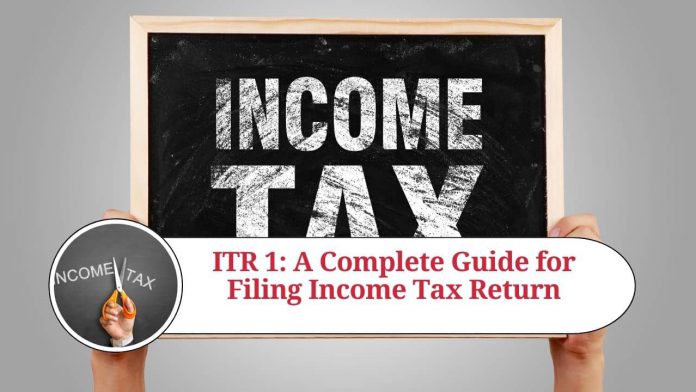Introduction
Income Tax Return or ITR is a document that contains information about a taxpayer’s income and tax liability for a particular financial year. It is mandatory for individuals and entities earning income to file their tax returns. ITR 1 is the most commonly used form for filing income tax returns in India. In this blog, we will provide a complete guide on ITR 1, including its features, eligibility, and filing procedure.
What is ITR 1?
ITR 1 is a simplified form for salaried individuals to file their income tax returns. It is also known as Sahaj form and can be used by individuals whose total income for the financial year does not exceed Rs. 50 lakh. ITR 1 is a one-page form that requires minimal details and can be easily filed online.
Eligibility to File ITR 1
ITR 1 is for individuals who meet the following conditions:
- Resident individuals who have earned income from salaries, pensions, or one house property.
- Income from other sources (excluding lottery and racehorse winnings).
- Total income of up to Rs. 50 lakh.
- Agricultural income of up to Rs. 5,000.
- Cannot be used by non-residents or individuals with foreign assets.
Features of ITR 1
- Simple and Easy to Fill: ITR 1 is a one-page form that requires only basic information, making it easy to fill and file.
- Electronic Filing: The form can be filed electronically, and the taxpayer does not need to submit a physical copy.
- Pre-Filled Data: The form automatically fills certain data such as the name, address, PAN, and tax deducted at source (TDS) details.
- Faster Processing: Electronic filing of ITR 1 ensures quicker processing of the tax return.
- Income Verification: The tax department can verify the taxpayer’s income and compare it with the data available with them.
Filing Procedure for ITR 1
- Gather Required Documents: Keep all necessary documents such as Form 16, bank statements, and TDS certificates ready.
- Download ITR 1: Download the ITR 1 form from the income tax department’s website or income tax e-filing portal.
- Fill the Form: Fill the form with the required information, such as personal details, income details, and tax paid details.
- Verify the Form: Verify the form and ensure that all information is correct.
- File the Form: Submit the form online and get an acknowledgment from the tax department.
- Verify the Return: Verify the return within 120 days of filing. This can be done online, or by sending a signed copy of the ITR-V to the tax department.
Common Mistakes to Avoid When Filing ITR 1
Filing ITR 1 can be a straightforward process, but there are a few common mistakes that taxpayers should avoid. These include:
- Entering incorrect information: Entering incorrect information such as PAN, bank account number, or other details can lead to errors and delay in processing the return.
- Not including all sources of income: It is essential to include all sources of income, including interest income, rental income, or income from investments.
- Not verifying the form: Failing to verify the form can result in the return being considered invalid.
- Not paying taxes on time: It is crucial to pay taxes on time to avoid any interest or penalty charges.
- Not reporting foreign assets: If a taxpayer has foreign assets, they should report them in their tax return, even if they are not taxable.
Benefits of Filing ITR 1
Filing ITR 1 offers several benefits, such as:
- Compliance with the law: Filing ITR 1 ensures compliance with the law and helps taxpayers avoid any penalties or legal action.
- Faster processing: Electronic filing of ITR 1 ensures faster processing of the tax return, and the taxpayer can receive their refund sooner.
- Proof of Income: Filing ITR 1 is proof of the taxpayer’s income, which can be useful when applying for loans or visas.
- Carry forward of losses: Filing ITR 1 allows taxpayers to carry forward their losses for future years.
- Avoiding tax notices: Filing ITR 1 on time can help taxpayers avoid receiving tax notices or reminders from the tax department.
Conclusion
ITR 1 is a simplified form for salaried individuals to file their income tax returns. It is a one-page form that requires only basic information and can be easily filed online. Filing ITR 1 is essential for compliance with the law, and it offers several benefits such as faster processing, proof of income, and the ability to carry forward losses. To avoid mistakes and ensure a smooth filing process, it is crucial to gather all necessary documents and verify the form before submitting it.
Read more useful content:
- How to Save Tax on Salary
- Guide to Understanding Direct Taxes in India
- Filing Income Tax Returns
- GST E-invoice
Frequently Asked Questions (FAQs)
Q1.) Can a non-resident file ITR 1?
No, only resident individuals are eligible to file ITR 1.
Q2.) Can individuals with foreign assets file ITR 1?
No, individuals with foreign assets cannot file ITR 1. They must file ITR 2 instead.
Q3.) Is it mandatory to file ITR 1?
Individuals with income exceeding the basic exemption limit are required to file their income tax returns, including ITR 1.
Q4.) What documents are required for filing ITR 1?
Documents such as Form 16, bank statements, and TDS certificates are required for filing ITR 1.
Q5.) Can I file ITR 1 offline?
No, ITR 1 can only be filed online.
Q6.) Can I revise my ITR 1 after filing?
Yes, taxpayers can revise their ITR 1 within the deadline for filing a revised return.
Q7.) Is it necessary to include agricultural income in ITR 1?
Yes, individuals with agricultural income of up to Rs. 5,000 are required to include it in their ITR 1.
Q8.) What are the consequences of not filing ITR 1 on time?
Late filing of ITR 1 can attract a penalty of up to Rs. 10,000, as well as interest on the tax payable. It can also lead to legal action by the tax department.




















